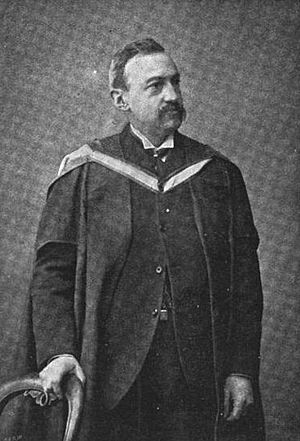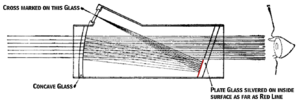Howard Grubb facts for kids
Quick facts for kids
Sir Howard Grubb
|
|
|---|---|

Sir Howard Grubb
|
|
| Born | 28 July 1844 |
| Died | 16 September 1931 (aged 87) |
| Nationality | Irish |
| Occupation | Engineer |
| Engineering career | |
| Significant design | Optical telescopes, Periscope Reflector sight |
Sir Howard Grubb (born July 28, 1844 – died September 16, 1931) was a super smart engineer from Dublin, Ireland. He was known for designing and building amazing optical telescopes. His family business made huge telescopes and other cool optical tools. He also helped make the periscope much better and invented the reflector sight.
Contents
Who Was Sir Howard Grubb?
Howard Grubb was one of eight children. His dad, Thomas Grubb, started the Grubb Telescope Company. Howard became interested in optics (the science of light) very early on.
Early Life and Career
He started studying at Trinity College Dublin in 1863. Even though he didn't finish his degree, he trained to be a civil engineer. In 1864, Howard joined his father's company. He quickly became known for making top-quality telescopes. In 1871, he married Mary Walker, and they had six children together.
Awards and Recognition
Howard Grubb was chosen as a Fellow of the Royal Society in 1883. He also became a Fellow of the Royal Astronomical Society in 1870. In 1876, Trinity College Dublin gave him an honorary Master's degree in Engineering. There's even an asteroid named after him!
In 1887, he was made a knight by the Lord Lieutenant at Dublin Castle. This meant he could be called "Sir Howard." He was a long-time member of the Royal Dublin Society. He served as an Honorary Secretary and later as a vice-president. In 1912, he received the Society's medal, a very special award. Sir Howard Grubb passed away in 1931.
Amazing Telescopes and Inventions
Under Howard Grubb, the Grubb Telescope Company became even more famous. They were known for making excellent optical instruments. Grubb also built very accurate electric motors for telescopes. These motors helped telescopes follow stars as the Earth turned.
Some of the huge telescopes he made include:
- The 27-inch refractor for the Vienna Observatory (built in 1878).
- The 10-inch refractor at Armagh Observatory (built in 1882).
- The 28-inch refractor at the Royal Observatory, Greenwich (built in 1893). This is the UK's largest refractor telescope.
- The 10-inch refractor at Coats Observatory, Paisley (built in 1898).
In 1887, Grubb's company built seven special telescopes called "astrographs." These were for a big international project called Carte du Ciel. The project aimed to create a photographic map of the entire sky.
The Reflector Sight
In 1900, Grubb invented the reflector or "reflex" sight. This is a special kind of sight that doesn't magnify things. It uses a collimator to show an illuminated image. This image, like a crosshair, appears in front of you and stays perfectly aligned with the device.
This type of sight is now used on all sorts of things. You can find them on small firearms and even fighter aircraft. It's also the main idea behind modern head-up displays, which project information onto a screen in front of a pilot or driver.
Periscopes for Submarines
During the First World War, Grubb's factory was very busy. They made many telescopic gun-sights for weapons. During this time, he also improved the design of the periscope. His new periscope design was perfect for Royal Navy submarines.
See also
- List of astronomical instrument makers


